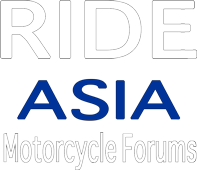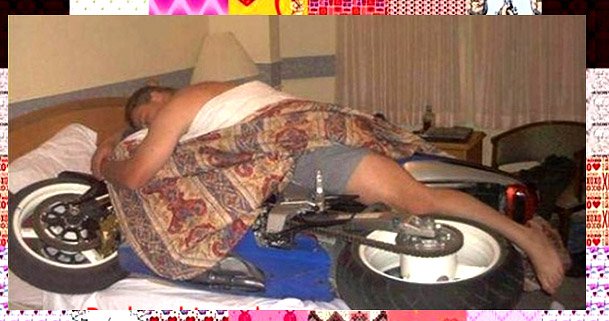Hey Tony,
Yes the bike was new and yes it should have been greased at the factory. However who knows what kind of journey these grey imports take on, and also remember it has been disassembled and rebuilt, to what extent I don't know. I would only be guessing the length of time it was sitting in a crate, bearings etc open to the elements. I wouldn't like to point fingers at a manufacturer or anyone else, its just something ive become accustomed to over the years, I actually enjoy taking bikes apart, finding problems and rectifying them, sad I know, but hey thats the way I am.
Using a camera has a few good uses when your stripping stuff down and carrying out maintenance. It serves as a running log of what you've done (no need for steps/entries in a notebook), you can quickly revert to a stage of disassembly for reference eg routing, its good for posting on forums like these (i hope it makes some interesting reading), it actually jogs my memory rather well when I flick through the photos before I start off on another day = fewer mistakes, and your always going to have these photos for years to come.
So what ive been getting up to over the past few days. I spent a good few hours rewiring the oem loom/harness to accommodate the addition of a fan with manual toggle switch, toggle switch for headlight, Vapor power/temp/tacho signals, Garmin harness. Its all been integrated into the existing harness properly ie wires not running directly off the battery, which is not wrong as long as you have the fuses in line etc, it just makes life easier for in the future when you have to remove it all again and it looks cleaner also.
This is the signal wire coming off the coil connector which in turn is converted in to your RPM (tachometer) reading on your Vapor.
Original speed sensor cable is now redundant as the vapor uses its own sensor. Snipped and blanked off with heat-shrink. I might be teaching some to suck eggs but always remember to leave enough tail incase you need to return the bike to stock for whatever reason.
After the electrics were all completed and ready for installation I had a wee break from the spanners and done some research for getting it green booked. After chasing my tail for a while and reading lots of posts on forums, and there is lots of information, some good some misleading, in-fact a lot of misleading information. I eventually narrowed my options down to three companies in Bangkok. And with help from my wife (my Jock accent and poor attempt at Thai doesn't come across very well!!!:huh

I have a company that will sort everything out for a fixed price. I hopefully will receive the excise proof of payment shortly after the 15th of April, this is included in the fee. Some time later I will have to send the bike to Bangkok for a week or so for them to put it through the emissions test. Ive used Logispost and you can send a 400cc bike or larger to Bangkok for 1,790 Baht. Contrary to what people are saying about the new legislation regarding the emissions test and Carburated bikes it can be done and has been done quite easily using the right people. Hopefully, fingers crossed (and toes) they tell me I should be legal in approx. 3 months after the emissions test. I'd like to also add if you go this route apparently its far easier for the company to get cracking with the process if all the import papers are in a Thais name.
So with that good news I picked up the spanners again.
Time to work on the engine a little. Cylinder head cover was removed to give the valve clearances a quick check. The WR comes with a couple of handy aides to assist bringing the engine to tdc. Remove both covers on the crank case, rotating the crankshaft, align the notch above up with the line on the rotor.
Theres also a secondary indication on the camshafts shown by aligning the two punch marks up horizontally.
There's a total of 5 valves to check, 2 intake and 3 exhaust. All were within the specified limits, however the one shown below was at the upper end of the tolerances for some reason, usually out the factory they are adjusted to the lower tolerance to allow for wear. Ill need to keep an eye on this one.
Now a word of caution. The feeler gauges that I purchased a wee while ago, some of the values are incorrect, the ones below for instance. You can see the floppy one which is obviously the thinner of the two, the metric reading is larger than the thicker one!!! aaaah I here you say thats what you get for buying gear made in China, nope it clearly has made in the USA stamped on it. What's the world coming to when you have to get calipers to check feeler gauges!!! It took me a while to figure it out, but I got there in the end.
I would have liked to remove the cylinder head but unfortunately the gasket kit hasn't arrived yet, so its on the jobs to do list. All external bolts were loosened re-seated and torqued, all good.
So that was yesterday. Today I spent a bit of time going over what I had done up till now before installing the engine. All good (I think).

So in she went. I took my time removing it and making a mental note of the angles required to get it out smoothly. So the reverse was carried out and it slipped in very easily.
So after this I spent a bit of time routing all cables, which took longer than expected as it wasn't done properly previously on rebuild. The routing diagrams from the manufacturers aren't the best but its all you have to get on with. What I did notice with the Scott Dampener mount bracket which is shown in a previous post. When you rotate the steering one of the throttle cables and the throttle position sensor catches on the pinch bolt/gap of the Scott clamp. Its only slightly but enough to cause problems over time. Something to keep in mind if you fit one of these.
All connectors were checked for continuity and resistance between each other (within bundles) and earth. The battery was also slaved in and operation of the Vapor and GPS was checked good. Fan and Headlight toggle switches operating correctly. The electric/ignition system was also fully checked and all results within spec. The spark plug gap of all things was to too big by 0.1mm
The colorful plastic fish you see above on the floor are part of a game my two young daughters are into at the minute. It comes with two whipping fishing rods with magnets on the end which is quite sore when it cracks you across the heed. This adds to the challenge of an already challenging project. :crazy:
I mentioned a few days ago how high the torques were on some of the bolts when I dismantled the bike, as if two or three mechanics had been bouncing on a 12ft long bar with a socket on the end. Well have a look at the picture below. I religiously use a torque wrench and refer to bike specific tables for correct values when re-building. Now as you can see these bolts aren't the best of quality (shame on you Yamaha) and is all the more reason to ensure you correctly stick to the correct torques. The torque for this bolt, and this is the lower engine mounting bracket bolt by the way!, is 38ft/lbs. Now thats not much but it managed to shear it quite easily, the reason because it had been well over torqued previously and just about passed it point of elasticity. You can actually feel this when torquing up. There were a few others that felt the same but managed to hold on until the required torque. I will be replacing these as a matter of course.

So that's me for the night, the front end is nearly complete, its sort of looking like a motorcycle again. Tomorrow ill try and get round to stripping down the Carb and giving it a good clean. And maybe get that fitted and give the engine a test before the rear end goes on.
Good night :yawn:































 I have a company that will sort everything out for a fixed price. I hopefully will receive the excise proof of payment shortly after the 15th of April, this is included in the fee. Some time later I will have to send the bike to Bangkok for a week or so for them to put it through the emissions test. Ive used Logispost and you can send a 400cc bike or larger to Bangkok for 1,790 Baht. Contrary to what people are saying about the new legislation regarding the emissions test and Carburated bikes it can be done and has been done quite easily using the right people. Hopefully, fingers crossed (and toes) they tell me I should be legal in approx. 3 months after the emissions test. I'd like to also add if you go this route apparently its far easier for the company to get cracking with the process if all the import papers are in a Thais name.
I have a company that will sort everything out for a fixed price. I hopefully will receive the excise proof of payment shortly after the 15th of April, this is included in the fee. Some time later I will have to send the bike to Bangkok for a week or so for them to put it through the emissions test. Ive used Logispost and you can send a 400cc bike or larger to Bangkok for 1,790 Baht. Contrary to what people are saying about the new legislation regarding the emissions test and Carburated bikes it can be done and has been done quite easily using the right people. Hopefully, fingers crossed (and toes) they tell me I should be legal in approx. 3 months after the emissions test. I'd like to also add if you go this route apparently its far easier for the company to get cracking with the process if all the import papers are in a Thais name.


































































































































































